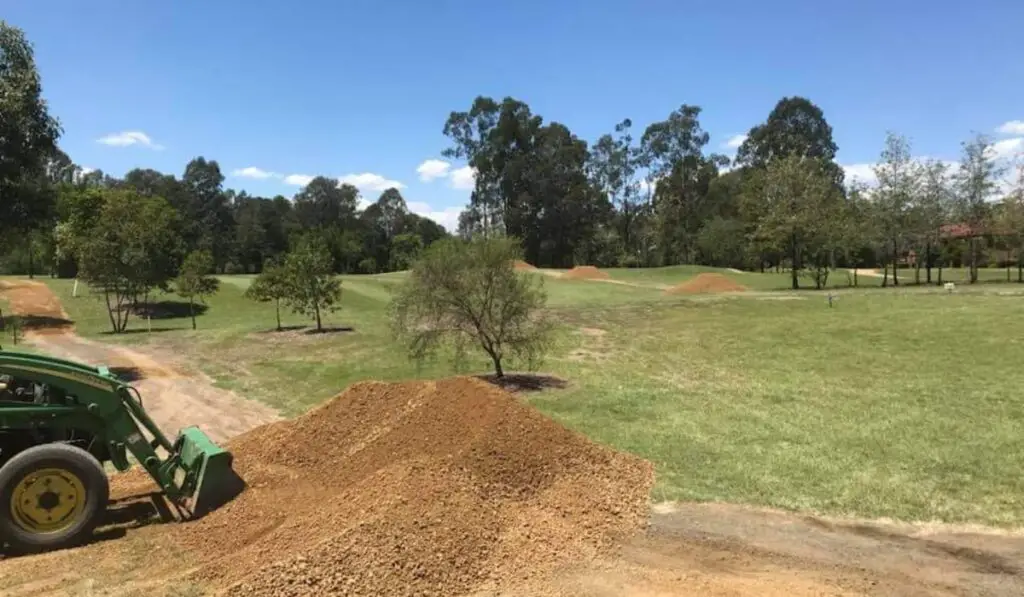Decomposed granite (DG) is an excellent option for many yards. Homeowners use this granite variant as garden mulch or landscaping features like pathways and patio flooring. But does decomposed granite landscape suit your landscape? Read on for the answers.
Contents
What Is Decomposed Granite?
Decomposed granite is a fine aggregate formed when granite rocks weather down and erode into tiny pieces. It has a similar appearance to gravel, apart from the fact that it is finer and has better stability. Since granite is a tough rock, decomposing takes time.
Decomposed granite for landscaping comes in 3 varying types. These are:
- Decomposed granite mixed with resin
- Loose decomposed granite
- Decomposed granite mixed with a stabilizer
Decomposed Granite Mixed With Resin
DG mixed resin, also known as poly pavement, is the most pricey of the three granite types. The resin in this type of DG is responsible for the asphalt appearance of the granite surface.
DG mixed with resin is not only the most robust option but the most durable compared to the others. When used in making pavements, it does not easily get tracked away under shoes or eroded by water.
The main demerit of poly pavement is that it does not have a natural look like stabilized or loose decomposed granite. Another downside is that resin-mixed granite doesn’t have good drainage compared to the other types of DG.
Standard Decomposed Granite (Loose DG)
Standard decomposed granite is popular because it’s the least expensive of the three. This DG variant comprises loose granite aggregates and has no additives.
You can use standard decomposed granite for mulching since it lacks artificial additives. Loose decomposed granite landscaping features such as sports courts, paths, gardens, and patios.
Due to its loose nature, this decomposed granite has excellent drainage preventing water runoffs. Also, when well compacted, it can form a relatively hard surface.
A major downside of loose decomposed granite is that it’s easily eroded. Due to this, it requires frequent refilling compared to other types of decomposed granites. It is also easy to track its particles when you walk over it.
As such, it’s not advisable to have landscape features with loose decomposed granite close to your home as it can be tracked into the house. When this happens, the particles can cause damage to your home’s flooring.
Decomposed Granite With a Stabilizer
As the name suggests, this type of DG is made up of granite aggregates that are mixed in with a stabilizer.
Stabilized decomposed granite is not as strong or durable as DG mixed with resins, but it is better in those two aspects than natural DG. As a landscaping option, it is more expensive than its loose counterpart but costs less than natural stone, pavers, or any decorative concrete.
After it is spread and compacted, stabilized DG will appear similar to that of loose DG. However, it is not easily eroded and needs less maintenance. Stabilized DG is a common and popular alternative to gravel in landscaping since it is softer and cheaper.
Decomposed Granite Pros and Cons
Like any other hardscaping choice, using the decomposed granite landscape option has its benefits and demerits.

Decomposed Granite Pros
- Using decomposed granite is cheaper than most other hardscaping and softscaping materials. A cubic yard of decomposed granite can cost between $40-50.
- Good drainage is something that most people look at as the reason to use DG. However, one should use stabilized or loose decomposed granite because of its excellent drainage.
- Using DG as a flooring material for patios and areas is an excellent idea since it is softer than gravel or concrete. It feels much better on your feet than gravel can. Due to its softness, it can be used in landscaping areas where children play or run around.
- Unlike most hardscaping landscaping alternatives, DG is easier to install. It can be set and installed in just a few hours, unlike concrete, which might require more than one day to install correctly.
- It comes in various colors and shades, allowing a lot of freedom for one to pick a type that fits in with their stylistic needs and creativity.
- It has a classic natural look that incorporates well with the natural environment and other landscape features installed on your property.
- Decomposed granite (loose DG) is a great garden or tree mulch option. Even after it has been laid down, it will continue to decompose, providing nutrients and minerals to the soil and plants.
- Decomposed granite landscaping has a longer life span and requires minimal upkeep.
Decomposed Granite Cons
- Requires the use of pavers when installing it in driveway or pathways to avoid it being eroded.
- It is easy to track away loose decomposed granite on your feet which is not a good thing, especially if installed close to home. The tracked particles can cause damage to the flooring in your home, particularly hardwood floors.
- It can get muddy, especially after massive rains.
- One of the disadvantages of decomposed granite is that weeds can still grow through installations. To avoid this problem, spray a herbicide and put a landscape fabric before installing decomposed granite.
Final Thoughts
Installing decomposed granite landscape features is one of the ways of implementing hardscaping.
Decomposed granite is affordable and can easily integrate with your other landscaping features because of its aesthetic and natural look.
The many benefits of decomposed granite and easy installation make it an excellent option for most outdoor hardscaping.
Hello! My name is Chris, and I am the founder of Yard Floor. When I was a toddler, my family had a lush green lawn. I was at the center of caring for and maintaining this lawn and even proceeded to take an associate’s Degree in landscaping. I am here to share my years of experience with you – be it repairing your mower/tractor or caring for your lawn.